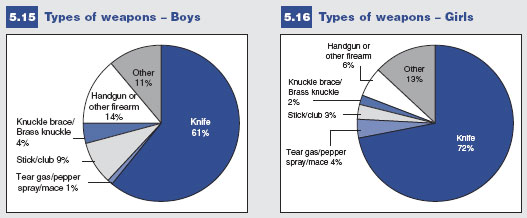Common menu bar links
Institutional links
Diseases & Conditions
Health & Safety
Research & Statistics
Agency Information
Search Box
Healthy settings for young people in Canada
Previous | Table of Contents | Next
How Young People are Victimized
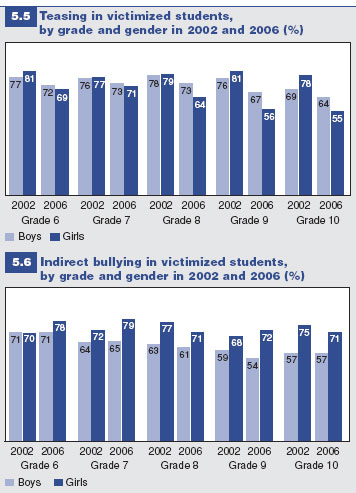 Bullying takes many forms,
with the two most common
(from 54% to 81%)
being teasing (Figure 5.5)
and indirect bullying such
as excluding or spreading
lies about the victim
(Figure 5.6). Significantly
more boys than girls report
being teased in 2006,
especially in older grades;
but, overall, the 2006 rates
are lower than in 2002
(Figure 5.5). In contrast,
more girls report being
victims of indirect bullying
(Figure 5.6).
Bullying takes many forms,
with the two most common
(from 54% to 81%)
being teasing (Figure 5.5)
and indirect bullying such
as excluding or spreading
lies about the victim
(Figure 5.6). Significantly
more boys than girls report
being teased in 2006,
especially in older grades;
but, overall, the 2006 rates
are lower than in 2002
(Figure 5.5). In contrast,
more girls report being
victims of indirect bullying
(Figure 5.6).
| Figures 5.5 to 5.11 display data for those students who report being victims or bullyvictims. |
Figure 5.7 shows that significantly more boys report physical victimization (up to 46%) in 2006, although these prevalence rates are lower than the 2002 results (when physical victimization reached as high as 55%).
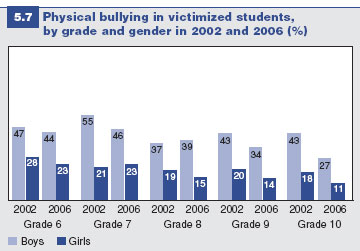
Reports of sexual harassment increase with age for girls, but decrease with age for boys, with similar levels of harassment for both genders at Grade 8 (Figure 5.8). Overall, the prevalence of reported sexual harassment in 2006 declined from 2002.
Bullying because of race and religion occurs less frequently than all the other types of bullying (Figures 5.9 and 5.10), ranging from 7 to 21%. Boys in all grades report more racial harassment and religious bullying than girls. There is a slight increase in reports of racial bullying from 2002 to 2006 and a slight decrease in reported religious bullying.
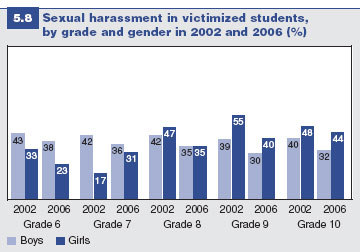
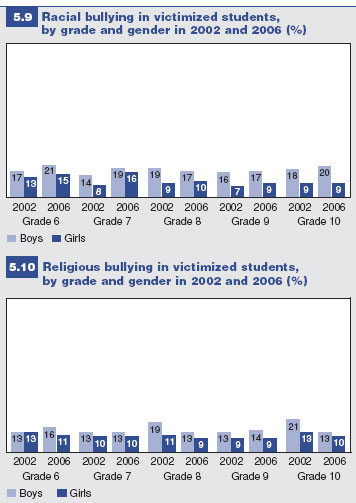
This survey cycle was the first time that the HBSC study asked students about electronic or cyber bullying, including computer postings, emails, digital photos, or cell phone harassment. Girls report that they experience more cyber bullying than boys in all grades (Figure 5.11).
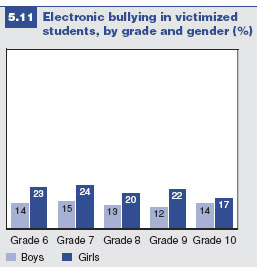
Fighting and weapon carrying
Physical fighting is an extreme form of aggression and merits serious attention.
Figure 5.12
shows that, compared to 2002, students are more involved in physical fights.
Significantly
more boys than girls in all grades report physical fighting behaviour. For
boys, fighting
behaviour decreases with age, while girls’ fighting is more consistent
across grades.
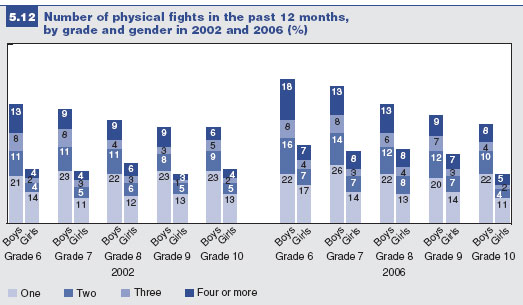
Almost one-half of boys indicate that the target of their physical fights
is most often a
friend or acquaintance (Figure 5.13), while girls indicate that they are
most likely to fight
with a sibling (Figure 5.14). It may be that girls are more likely to be
aggressive within the
confines of intimate family relationships or that it is more acceptable
to fight within these
relationships. Older students, especially boys, are more likely to fight
with strangers, which
could put them at risk for serious injury (not shown).

The proportion of students who carry weapons is similar to that for fighting
behaviour.
Seventeen percent of boys and 4% of girls report carrying weapons in the
past 30 days
(not shown).
As illustrated in Figures 5.15 and 5.16, those students who carry weapons
most often
carry knives. Fourteen percent of boys who carry weapons report that they
carry handguns
or other firearms. More girls who carry weapons carry tear gas or pepper
spray. The potential
risk for harm and escalating violence is of extreme concern with the increased
availability
and presence of weapons.
